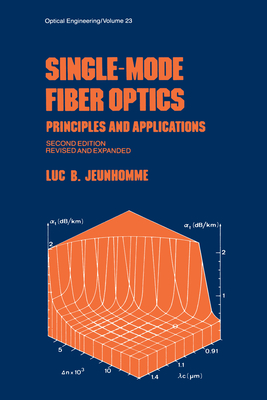Read Online Single-Mode Fiber Optics: Prinicples and Applications, Second Edition - L. B. Jeunhomme | ePub
Related searches:
Single-Mode Fiber Optics: Prinicples and Applications, Second
Single-Mode Fiber Optics: Prinicples and Applications, Second Edition
Optical Fiber - Introduction, Working, Principle, Types and FAQ
Optical Fiber : Working Principle, Types, Advantages and - ElProCus
Single-mode Fiber Optics. Principles and Applications. Second
Fiber Optic Cable Types – Multimode and Single Mode – RF
The light-guiding principle behind optical fibers was first demonstrated in victorian both multi-mode and single-mode fibers are used in communications, with.
A basic, unified reference, rather than a description of the current experimental activity, presenting the scientific and engineering principles of single-mode optical fibers.
An optical fiber refers to a flexible, thin fiber through which light can be transmitted via internal reflections. Optical fibers can take the form of single-mode or multimode fibers.
Single mode fiber optic cable has a small diametral core that allows only one mode of light to propagate. Because of this, the number of light reflections created as the light passes through the core decreases, lowering attenuation and creating the ability for the signal to travel further.
Single-mode fiber optics: principles and applications (optical engineering) by luc b jeunhomme and a great selection of related books, art and collectibles.
The small core and single light-wave virtually eliminate any distortion that could result from overlapping light pulses, providing the least signal attenuation and the highest transmission speeds of any fiber cable type. Single-mode optical fiber is an optical fiber in which only the lowest order bound mode can propagate at the wavelength of interest typically 1300 to 1320nm.
Single mode fibers are identified by the designation os or optical single-mode fiber. Single mode cable has a much smaller core (8-9um) than multimode cable and uses a single path (mode) to carry the light. The main difference between single mode os1 and os2 is cable construction rather than optical specifications.
Single-mode fibre (also referred to as fundamental or mono-mode fibre) will permit only one mode to propagate and, as such, cannot suffer mode delay differences. 40 ghz) and are, therefore, ideally suited for long-haul and high capacity circuits.
This chapter emphasizes the nature of optical modes and their group velocities in step-index and graded-index fibers. The optical properties of the fiber material (which is usually fused silica),.
Faster, more reliable and more durable, fiber optic offers a variety of benefits that are attractive to homeowners and businesses alike. If you're thinking of installing fiber optic cable, this guide will give you a good overview of things.
Single-mode optical fibers are much more expensive as it involves precise calculations to produce light in small openings. Multi-mode optical fiber has a larger core opening that bounces and reflects throughout the path, transmitting it through a shorter distance.
Optical fiber connectors- connector types, single mode fiber connectors, optical detectors and receivers: physical principles of pin and apd,.
Single-mode fiber optics: prinicples and applications, second edition, (optical science and engineering) [jeunhomme] on amazon.
Advertisement now that we know how fiber-optic systems work and why they are useful -- how do they make them? optical fibers are made of extremely pure optical glass. We think of a glass window as transparent, but the thicker the glass gets.
In this chapter we introduce the principles of light transmission in optical fibers. One of the difficulties associated with light propagation in multimode fibers.
A fiber optic cable is a thin glass strand used for transmitting light. Fiber optic cables are used primarily by telephone companies and electric companies. They are typically either single mode or dual mode, also called multimode.
The optical fiber cables are classified into two types based on the mode of propagation light which include the following.
Advertisement why are fiber-optic systems revolutionizing telecommunications? compared to conventional metal wire (copper wire), optical fibers are: less expensive - several miles of optical cable can be made cheaper than equivalent lengths.
Welcome back, fiber geeks! the first article in this series focused on growth in bandwidth demand and attenuation in optical fibers. Article 2 focused on several types of dispersion that exist in fiber, followed by article 3 – fiber strength and reliability. This article, the fourth in the series, will focus on single-mode fiber geometries.
Fiber optics, the technique of transmitting light through transparent, flexible fibers of glass or plastic. Advertisement fiber optics, the technique of transmitting light through transparent,.

Post Your Comments: